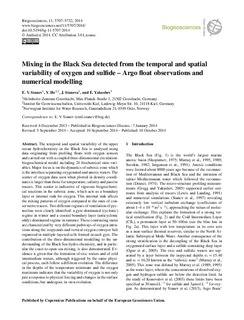| dc.contributor.author | Stanev, Emil Vassilev | |
| dc.contributor.author | He, Yunchang | |
| dc.contributor.author | Staneva, Joanna | |
| dc.contributor.author | Yakushev, Evgeny | |
| dc.date.accessioned | 2015-01-20T09:50:01Z | |
| dc.date.accessioned | 2015-01-21T10:58:16Z | |
| dc.date.available | 2015-01-20T09:50:01Z | |
| dc.date.available | 2015-01-21T10:58:16Z | |
| dc.date.issued | 2014 | |
| dc.identifier.citation | Stanev, E.V., et al., 2014. Mixing in the Black Sea detected from the temporal and spatial variability of oxygen and sulfide: Argo float observations and numerical modelling. Biogeosciences 11(20) 5707-5732 | nb_NO |
| dc.identifier.issn | 1726-4170 | |
| dc.identifier.uri | http://hdl.handle.net/11250/274463 | |
| dc.description | - | nb_NO |
| dc.description.abstract | The temporal and spatial variability of the upper
ocean hydrochemistry in the Black Sea is analysed using
data originating from profiling floats with oxygen sensors
and carried out with a coupled three-dimensional circulationbiogeochemical
model including 24 biochemical state variables.
Major focus is on the dynamics of suboxic zone which
is the interface separating oxygenated and anoxic waters. The
scatter of oxygen data seen when plotted in density coordinates
is larger than those for temperature, salinity and passive
tracers. This scatter is indicative of vigorous biogeochemical
reactions in the suboxic zone, which acts as a boundary
layer or internal sink for oxygen. This internal sink affects
the mixing patterns of oxygen compared to the ones of conservative
tracers. Two different regimes of ventilation of pycnocline
were clearly identified: a gyre-dominated (cyclonic)
regime in winter and a coastal boundary layer (anticyclonic
eddy)-dominated regime in summer. These contrasting states
are characterized by very different pathways of oxygen intrusions
along the isopycnals and vertical oxygen conveyor belt
organized in multiple-layered cells formed in each gyre. The
contribution of the three-dimensional modelling to the understanding
of the Black Sea hydro-chemistry, and in particular
the coast-to-open-sea mixing, is also demonstrated. Evidence
is given that the formation of oxic waters and of cold
intermediate waters, although triggered by the same physical
process, each follow a different evolution. The difference
in the depths of the temperature minimum and the oxygen
maximum indicates that the variability of oxygen is not only
just a response to physical forcing and changes in the surface
conditions, but undergoes its own evolution. | nb_NO |
| dc.language.iso | eng | nb_NO |
| dc.publisher | European Geosciences Union | nb_NO |
| dc.relation.uri | http://www.biogeosciences.net/11/5707/2014/bg-11-5707-2014.html | |
| dc.rights | Attribution 3.0 Unported (CC BY 3.0) | * |
| dc.rights.uri | https://creativecommons.org/licenses/by/3.0/ | * |
| dc.rights.uri | https://creativecommons.org/licenses/by/3.0/ | |
| dc.title | Mixing in the black sea detected from the temporal and spatial variability of oxygen and sulfide: Argo float observations and numerical modelling | nb_NO |
| dc.type | Journal article | nb_NO |
| dc.type | Peer reviewed | nb_NO |
| dc.date.updated | 2015-01-20T09:50:01Z | |
| dc.rights.holder | © Author(s) 2014 | |
| dc.source.journal | Biogeosciences | nb_NO |
| dc.identifier.doi | 10.5194/bg-11-5707-2014 | |
| dc.identifier.cristin | 1199935 | |

